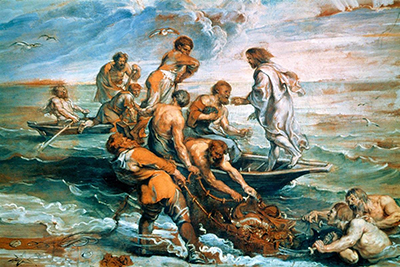The Miraculous Draught of Fishes is an art of work that was originally created between the years 1515 to 1516 by Raphael Sanzio who was an Italian artist during the Renaissance period.
The art was designed for his art tapestry. The art is described as one of 10 Raphael's cartoons created for draperies that were to be manufactured in a workshop at Brussels. The workshop was owned by Pieter Van Aelst's. The art recounts an episode in the Bible recorded in Luke 5:1-11 where Jesus addresses a crowd by the shore. The designs made by Raphael Sanzio are revolutionary works that represented the fine art tapestry of the Italian Renaissance art.
The weaving methods used by Raphael did not apply the traditional fresco painting associated with most of the art of that time. The art was a true pictorial; rendering showing the freedom that was given to the figures where they could move freely in space in unison with the natural light and the atmosphere.
The artist used body colour and varnish oil paints underdrawings over the charcoal drawings made on a paper. The paper that the drawings were made on were mounted on canvas. Raphael's art technique of using thick paint brushes and oil varnish medium for shadows and garments which are dark are influenced by Perugino style of art. The Florentine style of art and the monumental quality seen in the painting is influenced by Fra Bartolomeo style. Fra Bartolomeo was his close friend.
The art shows Simon Peter kneeling before Jesus pleading with him to leave the sinking boat after miraculously catching fish during the day in a section of the sea that was unlikely to have any fishes. There are cranes on the foreground which is a representation of the vigilance with some people believing that they were a symbolism of the pope role of watching over their believers. The seagulls represent the sins and apostasy. Other significant drawings in the drawing are Ravens flying above, and the white swans that are observed on the background. There are also crabs, fishes and eels.
At the bottom of the art's tapestry is a simulation of the life of Medici Pope Leo X. the Simulation shows the arrival of the papal conclave. The pope was attending his formal election in 1513 in Rome. The painting by Raphael Sanzio on the miraculous draught of fishes was one of the many art tapestry designs made for the Sistine Chapel and commissioned by Medici Pope Leo X. The Sistine Chapel was Leo X private chapel and therefore the art was added to his collection. The art is now in the custody of Victoria and Albert Museum of London.
The art was also later done by Jacopo Bassano, a late 16th-century painter from Venice. The art by Bassano was the latest during that era and only came to be recognized in 1989. Other artists who painted similarly themed work as Raphael are Titian, Veronese and Tintoretto. Bassano's art was considered the most extraordinary painting of that time due to its quality.




